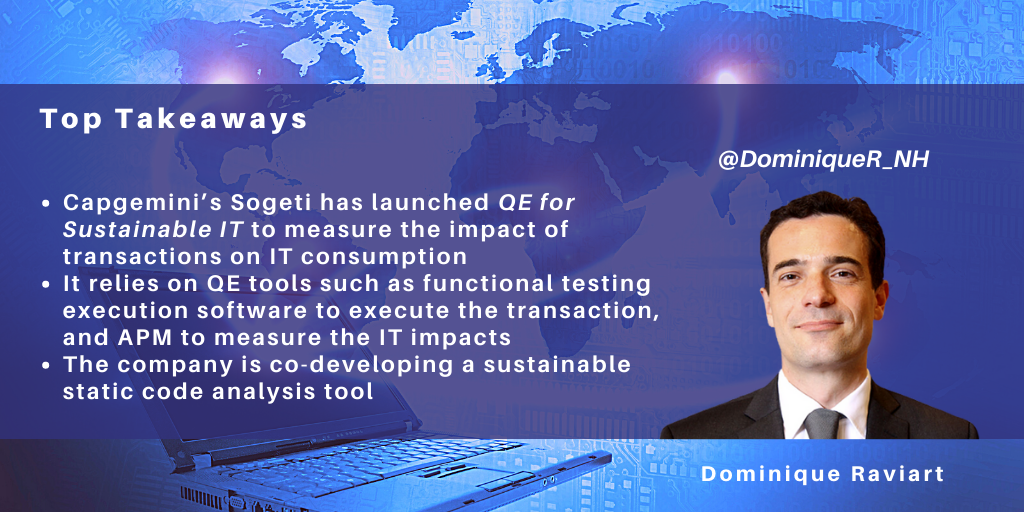Search posts by keywords:
Filter posts by author:
Related NEAT Reports
Other blog posts
posted on Jul 11, 2022 by Dominique Raviart

There is a big divide between IT sustainability and quality engineering (QE). In IT, sustainability is emerging from a carbon emission niche, expanding from a consulting to an execution phase. In QE, the focus remains primarily on functional automation with continuous testing/DevOps and AI as primary drivers. In short, the two have little in common.
As such, we had not anticipated that QE could soon become part of sustainability initiatives. However, Sogeti, part of Capgemini, recently briefed NelsonHall on how it is adapting its QE offering to sustainability with QE for Sustainable IT.
Measuring carbon footprint at the transaction level
Sogeti has designed QE for Sustainable IT, targeting the environmental side of sustainability (which also includes economic and social aspects). The company promotes a stepped transformation of IT rather than through big bang approaches. It highlights that once a client has started measuring its carbon footprint, it implements its strategy primarily by reducing its application estate and migrating its applications to the cloud.
Sogeti wants to offer a different approach to transformation, looking at the transaction level. The company will initially conduct its Green quality assessment, relying on its VOICE model, to understand the client’s sustainability objectives. Sogeti will then identify the most used ones in the production environment. It will then estimate how each transaction impacts the usage of hardware and networks (e.g., CPU, storage). Once done, the company will calculate the carbon footprint of each ERP transaction in production environments in the past 12 months. Once the applications have been transformed, Sogeti will reculcate the carbon emissions and measure its progress.
Where does QE fit within IT sustainability?
With its test case/test script approach, Sogeti highlights that QE already has the required experience and tools. The company will conduct the transaction, using functional test execution tools to measure the usage of hardware and networks. It will then capture each transaction’s hardware and network usage using APM tools.
Sogeti has worked with its development peers on the transformation side. The development teams will work on the code related to the ERP transaction, streamline the code, and remove dead code.
Sogeti looks to extend beyond this transformation phase and become a “sustainability quality gate”, mirroring the traditional role of testing in deciding if an application in development can be deployed in production environments. To do so, the company is currently working with a partner to build accelerators, e.g., a sustainable static code analysis to measure the “sustainability technical debt” of an application. The tool relies on checking if developers used sustainable development best practices.
This is just the beginning of Capgemini’s QE journey into sustainability. It sees increasing traction, thanks to regulatory pressure and consumer expectations, to reduce the carbon footprint of enterprises.
Capgemini’s roadmap for QE for Sustainability goes beyond ERP applications. The company wants to expand to other COTS and custom applications. With Capgemini’s CEO driving the company’s sustainability effort both internally and to external clients, expect to see more of these offerings in the next few months.
